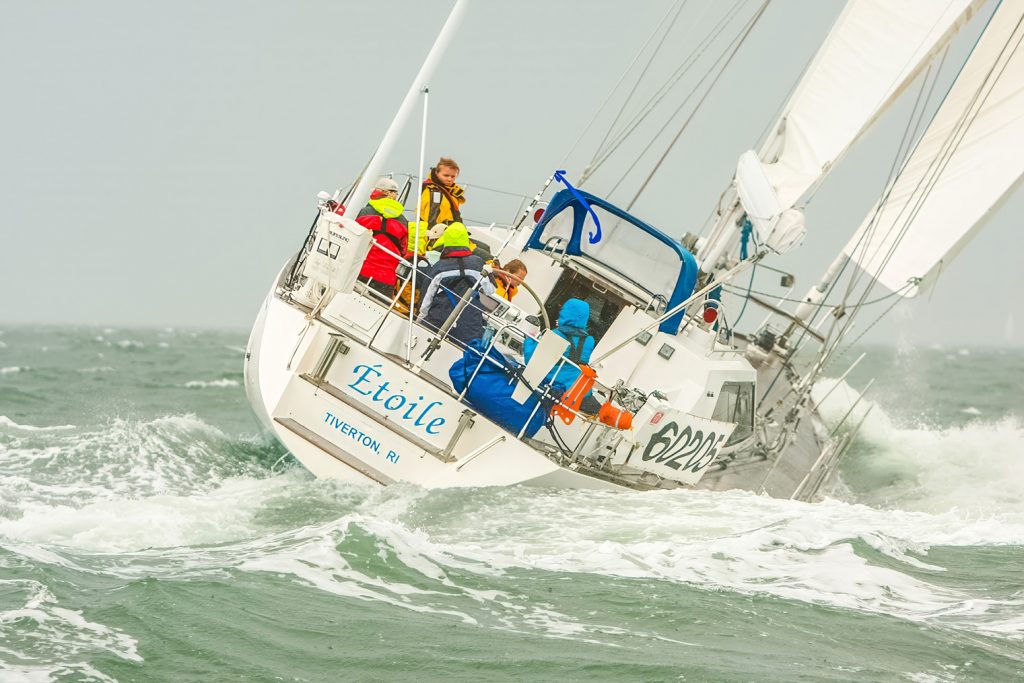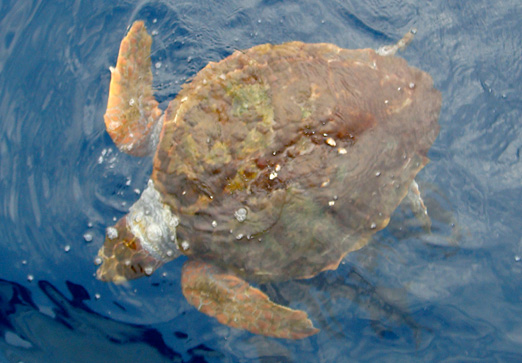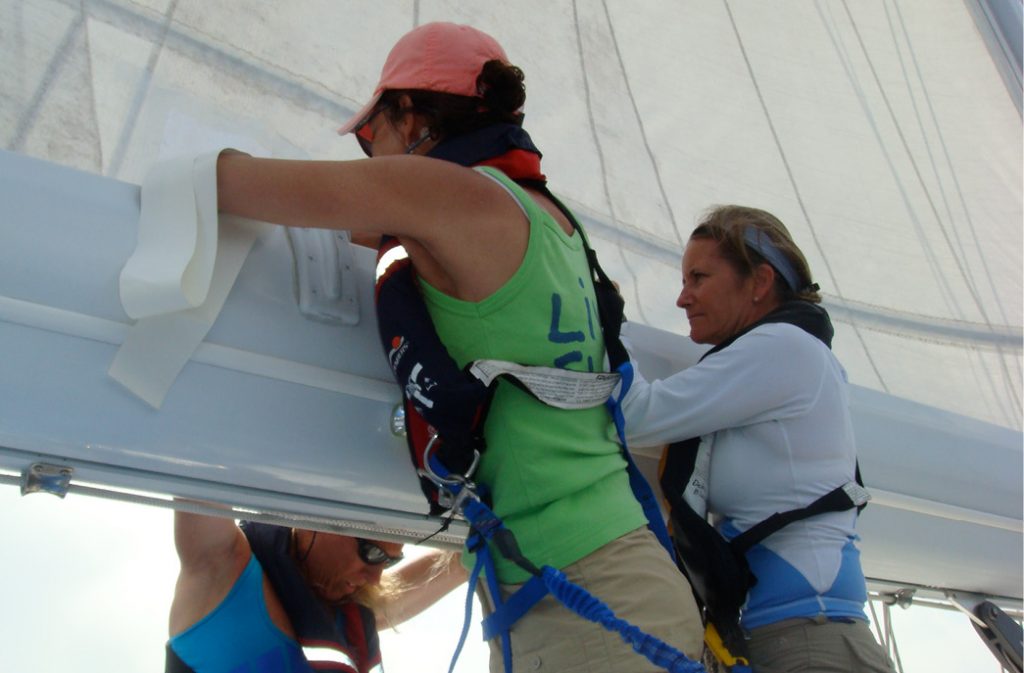My first Marion Bermuda Race
By Anne Kolker

Buzzards Bay served up abundant breeze at the start of the author’s first Marion Bermuda Race. © Spectrum Photo/Fran Grenon
Having asked many sailors if they would be my crew for a Marion Bermuda Race, I was often told that they were uncomfortable to lose sight of land. My reply has always been that I am much more uncomfortable to be along a shoreline in the fog. Of course, I have lots of electronic equipment to help me know my position and to find other boats or ships that might be in my vicinity. So, fog isn’t quite as challenging as it might have been before such equipment was readily available.
Long before GPS, AIS and radar were commonplace, mariners of all sorts have left the shores to cross bodies of water large and small. It just requires navigation skills and a willingness to seek adventure. The thrill of watching sunrise, sunset, emergence of stars or a developing weather front as you stand watch on the open ocean must be experienced because words are insufficient.
Adventure and growth of many skills is exactly what you get when doing an offshore race or passage. Weather forecasts are reliable for a day or two out at best. Current tables or Gulf Stream charts allow you to attempt to take advantage of favorable currents and avoid negative impact. Since you can’t stop along the way as if it were a road trip, you must take stock of all supplies you might need and be prepared.
My first Marion Bermuda Race, in 2011, started with winds gusting over 30 knots on a close-hauled tack. We reefed the main and genoa and took off. My first thoughts were that I’d reached a moment of pure insanity, but my crew, who were much more experienced than I, seemed totally at ease. So, I clutched the wheel and kept going.

Our visiting turtle
Once we finished beating our way down Buzzards Bay, which in my opinion is one of the biggest challenges of the race, we turned towards Bermuda, a mere 625 or so more miles to go. The evening brought a line of thunderstorms which my navigator insisted we avoid to protect all my new electronics. It was also to our advantage to be a bit more west of the rhumb line. We had a great night of sailing with good wind to take us towards the Gulf Stream.
I quickly learned that every day on the open ocean can be very different. The next day as the wind died down, we were moving slowly along. It was so calm that one of my crew decided to polish her nails. Then we noticed a large sea turtle swimming back and forth under the boat. What a difference a day makes.
As we sailed towards the Gulf Stream, my crew noticed a tear developing in the mainsail. We lowered the sail to make the tear accessible at the level of the boom, and grabbed our sail tape to make the repair. It was a team effort to hold everything still enough and stay stable to make the repair. We finished the job and returned to race mode.
Our approach to the Gulf Stream seemed easy with good wind to sail through. The stream is identifiable by the small line of puffy clouds that line the edges. I had been warned to expect a bumpy ride akin to jumping over Volkswagens. I knew my boat was sturdy enough to handle rough water, but the rock and roll made it preferable to be on watch rather than trying to sleep below. Luckily, the trip across the Stream ended in the late evening making sleep possible. The other benefit of crossing the Gulf Stream is that the weather begins to get much warmer. Long underwear is no longer needed.
The next challenge was that our refrigeration seemed to have failed. We were a few days out from Bermuda with supplies that might or might not survive the warming temperatures. Although my crew insisted that we have no “outside help” as a rule of the race, they allowed me to call my yard to see if there was any hope to revive the system. My mechanic listened carefully. He then suggested that I take a rubber mallet and bang on the refrigeration unit located in the aft lazarette. If once didn’t work, I should try again. He thought that the “alternator brushes” were stuck and a good bang would dislodge them. It worked! I have since learned that a heavy rubber mallet is a critical tool for fixing things that have stopped working. Just can’t get too carried away with the banging! But it often works.
We approached Bermuda in the morning with good wind and a bit of chop coming off the reefs. The Bermuda longtails flying around us and the fragrant smell of a flowering island gave proof positive of the destination we could not yet see. We began to identify the large buoys marking the formidable reefs that surround the island.

We made it to Bermuda!
We took a few big waves over the bow and along the port side with some water spilling into the aft lazarette. Suddenly, the chart plotter indicated that we were approaching Africa. Then it went blank. In fact, all the instruments went blank. Our plan B was to use a laptop computer with a GPS connection. My navigator had been using it as an adjunct to follow our trip. Now we needed it to get us past the reefs to the finish line and into the three-hour passage into the harbor. Using the compass and spotting buoys in the daylight made the final leg of our voyage a little more old-school, but another fun challenge.

Sail repair underway
When we crossed the finish line, I was exhilarated. What an incredible journey! We received permission to enter the cut leading into the harbor from Bermuda radio which handles all traffic into and out of Bermuda. The beautiful turquoise waters and warm winds made us all happy to have arrived. We reached the RHADC fondly known as the Dinghy Club to accomplish one last feat. I needed to dock my boat by backing into the slip. Since my docking skills were extremely limited at that point, I was terrified especially with a full audience of sailors at the club. The dockmaster quickly suggested that we line up as best we could near the slip and throw his dockhands our lines. They slowly pulled us into the slip. Mission accomplished. And we were met by a friend who delivered a tray of Dark and Stormy’s for our entire crew.
Once we had cleared customs and immigration, we settled into cleaning ourselves and the boat. We learned that we had finished well, not dead last, and that we had won the Faith Paulsen Trophy for all-female crew. At the time, I thought that I had “been there, and done that” but I slowly began to realize that once was not enough. There was too much adventure and experience to be had on this amazing offshore race. So, I have done five all-female crew Marion Bermuda Races. They have all been different. I have learned an enormous amount about my boat and sailing. It is the journey that counts. ■
Organized by the Marion Bermuda Cruising Yacht Race Association and supported by the Beverly Yacht Club, the Blue Water Sailing Club and the Royal Hamilton Amateur Dinghy Club as well as Marion and Boston, MA and Paget, BDA, the Twenty-fourth Marion Bermuda race starts Friday, June 20. To learn more and register, visit marionbermuda.com.
Dr. Anne Kolker has hosted all-female crews in offshore races from New England to Bermuda and inspired dozens of women to seek out sailing opportunities. In 2023, the Boat Owners Association of the United States and the National Women’s Sailing Association honored her with the Leadership in Women’s Sailing Award, which recognizes an individual with a record of achievement in inspiring, educating, and enriching the lives of women through sailing.
Anne’s crews are five-time winners of the Faith Paulsen Trophy, awarded to the fastest all-women team in the Marion Bermuda Race. Anne has offered her medical knowledge on ocean crossings and safety at sea, has been instrumental in developing race strategies, and has lectured to teams about safety practices. She has given lectures at NWSA events and is a leader at Safety at Sea programs, preparing crews for unexpected medical events. She is credited with saving the life of a crew member during a transatlantic passage. She’s a member of the Cruising Club of America, the Ocean Cruising Club, Stonington Yacht Club, and New York Yacht Club.




